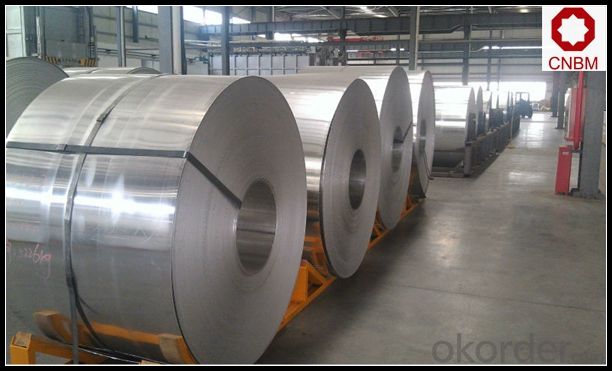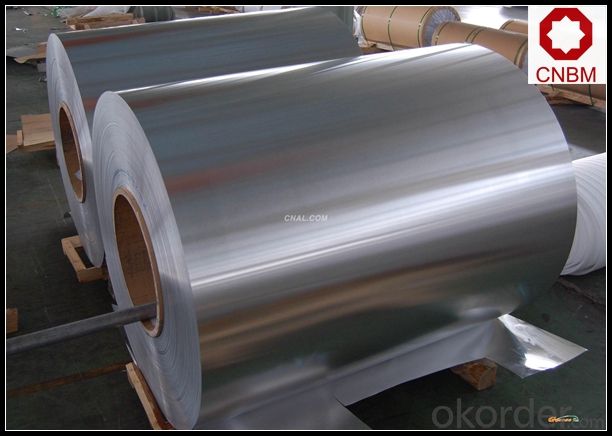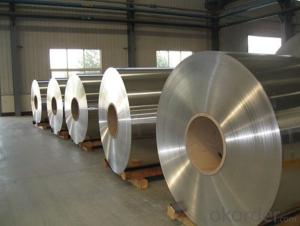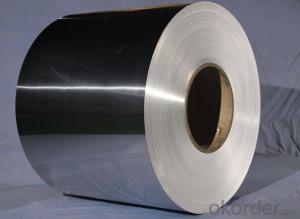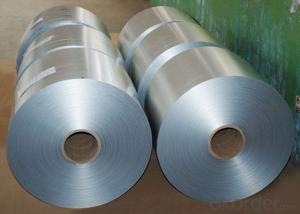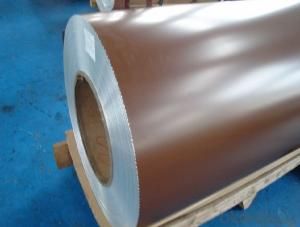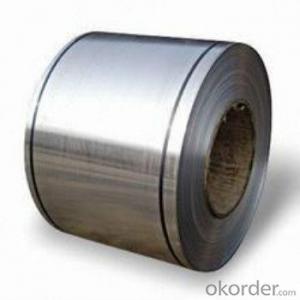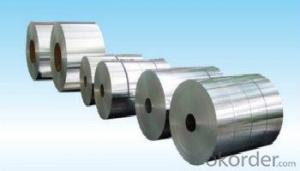Aluminum Steel Coil - Mill Finish Aluminum Coils 3003 H14 H24 Factory Selling
- Loading Port:
- Shanghai
- Payment Terms:
- TT OR LC
- Min Order Qty:
- 5 m.t.
- Supply Capability:
- 10000 m.t./month
OKorder Service Pledge
OKorder Financial Service
You Might Also Like
Specification
1. Specification of Mill Finish Aluminum Coils 3003 H14 H24 Factory Selling
Alloy: 1050, 1060, 1100, 3003, 3004, 3005, 3105, 5005, 5052, 5083, 5754
2) Temper: Various status
3) Thickness: 0.3-150mm
4) Width: 300-1950mm
5) Length: Under9500mm/ Coil
6) Weight: 2.5-5.0 tons per coil
7) Dimensions and weight can be produced according to clients' specifications.
8) Inner Diameter: 505mm, 605mm
9) Packing: Export standard, wooden pallet.
10) Delivery time: 20 days
11) Minimum order quantity: 5 tons per size.
12) The term of payment: T/T, irrevocable L/C at sight.
13) Surface: Bright
14)Origin: China
2. Application of Mill Finish Aluminum Coils 3003 H14 H24 Factory Selling
(1).Interior: wall cladding, ceilings, bathrooms, kitchens and balconies, shutters, doors...
(2).Exterior: wall cladding, facades, roofing, canopies, tunnels,column covers , renovations...
(3).Advertisement: display platforms, signboards, fascia, shop fronts...
3. Feature of Mill Finish Aluminum Coils 3003 H14 H24 Factory Selling
*Such coil is specially designed to replace aluminum ingot, due to the high export tax of aluminum ingot, the coil has better price than ingot.
*This type of coil can fit customer's remelting furnace just like ingot, no need to make any change to the production line that was previously used for ingot. The standard coil size and weight is very suitable for the feed gate of furnace.
*This type of coil causes less material wastage than ingot when remelted.
*Our coil is made directly from ore, no need to go though the ingot making process, quality is much better than other suppliers who use ingot scrap to make coil.
Be free from Oil Stain, Dent, Inclusion, Scratches, Stain, Oxide Dicoloration, Breaks, Corrosion, Roll Marks, Dirt Streaks and other defect which will interfere with use
4. Certificate:
SGS and ROHS(if client request, paid by client), MTC(plant provided), Certificate of Origin(FORM A, FORM E, CO), Bureau Veritas and SGS (if client request, paid by client), CIQS certificate
5. Image of Mill Finish Aluminum Coils 3003 H14 H24 Factory Selling

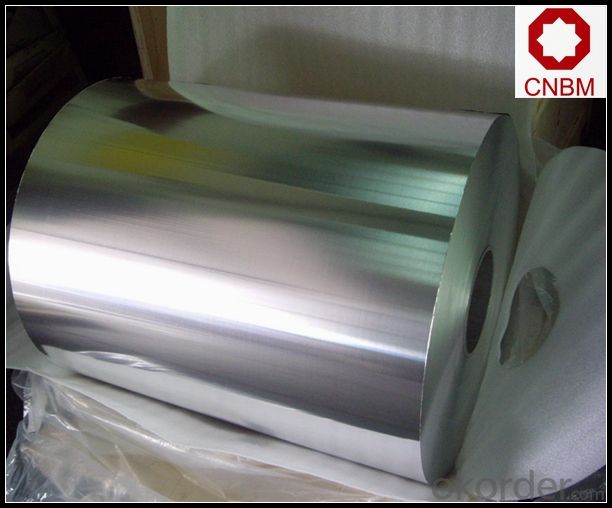
6. Package and shipping of Mill Finish Aluminum Coils 3003 H14 H24 Factory Selling
eye to wall
eye to the wall
with wood pallet (wooded case also available)
7. FAQ
1) What is the delivery time?
Dpends on actual order, around 20 to 35 days
2)What is the QC system:
We have QC staff of 20 persons and advanced equipment, each production is with MTC traced from Aluminum ingot lot.
3) What market do you mainly sell to?
Australia, America, Asia, Middle East, Western Europe, Africa etc
- Q: How do aluminum coils compare to other types of coils (e.g., copper)?
- Aluminum coils and copper coils are two common types of coils used in various industries. While both have their own advantages and disadvantages, it is important to understand how they compare to each other. One of the main differences between aluminum and copper coils is their conductivity. Copper is known for its excellent electrical and thermal conductivity, making it a preferred choice for applications that require high levels of heat transfer efficiency. Aluminum, on the other hand, has a lower conductivity compared to copper, but it is still a good conductor of electricity and heat. Another key factor to consider is the cost. Copper is more expensive than aluminum, primarily due to its higher demand and limited availability. Therefore, aluminum coils are often chosen as a cost-effective alternative, especially in applications that do not necessarily require the high conductivity of copper. In terms of weight, aluminum coils are significantly lighter than copper coils. This makes them easier to handle and install, reducing overall transportation and labor costs. The lightweight nature of aluminum coils also makes them suitable for applications where weight is a concern, such as in the automotive and aerospace industries. When it comes to corrosion resistance, copper coils have the upper hand. Copper is highly resistant to corrosion, ensuring longer lifespan and less maintenance. Aluminum, on the other hand, is more prone to corrosion, especially in environments with high humidity or exposure to certain chemicals. However, with proper coatings and treatments, aluminum coils can be protected against corrosion effectively. Durability is another aspect to consider. Copper coils are known for their durability and ability to withstand extreme conditions, making them suitable for applications where longevity is crucial. Aluminum coils, while not as durable as copper, can still provide satisfactory performance in many applications, especially when properly designed and maintained. In summary, aluminum coils and copper coils have their own distinct characteristics and advantages. Copper coils offer superior conductivity, corrosion resistance, and durability, but they come at a higher cost. Aluminum coils, on the other hand, are lighter, more cost-effective, and suitable for various applications. Ultimately, the choice between the two types of coils depends on the specific requirements, budget, and environmental factors of the application at hand.
- Q: What is the composition of aluminum coils?
- Pure aluminum coils typically contain 99.5% aluminum and trace amounts of other elements. Conversely, aluminum alloys are formed by blending aluminum with metals like copper, magnesium, manganese, or zinc. These alloys are specifically engineered to bolster the strength, corrosion resistance, and other desired characteristics of the aluminum coils. The precise composition of the coils may differ based on the particular application and requirements, but in general, they contain a significant proportion of aluminum along with small quantities of other elements to yield a sturdier and more effective product.
- Q: What are the different coil slitting options available for aluminum coils?
- Aluminum coils can be slit in several ways to meet specific requirements and achieve desired outcomes. 1. The most common method is single-loop slitting, where the coil is fed through rotating circular knives to make a single cut along its length. This creates narrower coils with the desired width. 2. Double-loop slitting is similar to single-loop slitting, but the coil is passed through the circular knives twice, resulting in two narrower coils. This method is preferred when precise width tolerances are necessary. 3. Rotary slitting involves feeding the coil through rotating knives that make multiple cuts simultaneously. This allows for the production of numerous narrow strips in one pass, making it ideal for high-speed production. 4. Crush cutting utilizes opposing circular knives, with one stationary and the other rotating. The knives crush and shear the aluminum coil, providing precise slitting. This method is suitable for thin coils and applications that require minimal burr. 5. Shear slitting uses upper and lower straight knives to cut through the coil. The knives move in opposite directions, creating a shearing action that produces clean and accurate slits. This method is preferred for thicker coils. 6. Laser slitting is a modern and highly precise method that employs a laser beam to make cuts in the aluminum coil. It offers exceptional accuracy and clean edges, making it suitable for high-end applications with strict tolerances. Each of these coil slitting options possesses distinct advantages and is selected based on factors such as required width tolerances, coil thickness, production speed, and desired edge quality. Manufacturers choose the most appropriate method based on their specific needs and the characteristics of the aluminum coils they work with.
- Q: Can aluminum coils be used in agricultural applications?
- Yes, aluminum coils can be used in agricultural applications. Aluminum is a versatile and durable material that can withstand various environmental conditions, making it suitable for agricultural equipment such as irrigation systems, greenhouse structures, and ventilation systems. Additionally, aluminum's light weight and corrosion-resistant properties make it an ideal choice for agricultural applications where durability and long-term performance are essential.
- Q: Dongying power plant with 0.6mm thick insulation aluminum coil, manufacturers can be divided into small volumes?
- How wide is the inside diameter of an aluminum roll; a roll of multiple. Small volume of MOQ is required.
- Q: high-quality hi-fi power and amplifiers generate large amounts of heat. to dissipate the heat and prevent damage to the electronic components, heat-radiating metal fins are used. would it be better to make these fins out of iron or aluminum? specific heat capacities for aluminum and iron are 0.89 J/degrees C.g and 0.45 J/degrees C.g, respectively. explain your answer
- Aluminum has high specific heat than iron which means more energy is require to change aluminum temperature than it of iron. A good conductor is a good emmiter so aluminum will be a best choice since it will not heat up as much as iron for the same amount of mass and energy imput.
- Q: What are the different color options for coated aluminum coils?
- Coated aluminum coils are available in a wide range of color options to suit various aesthetic preferences and project requirements. Some of the common color options for coated aluminum coils include white, black, silver, gray, bronze, gold, red, blue, green, and brown. These colors can be achieved through different coating processes and techniques, such as powder coating, PVDF coating, or polyester coating. Additionally, custom color options are also available, allowing customers to choose a specific color that matches their design vision or brand identity. The color options for coated aluminum coils provide versatility and flexibility, enabling them to be used in various applications, including building facades, roofing systems, signage, interior decoration, and more.
- Q: What are the standard sizes of aluminum coils?
- The standard sizes of aluminum coils can vary depending on the specific industry and application. However, there are a few common standard sizes that are widely used. For general industrial applications, the standard width of aluminum coils ranges from 36 inches to 72 inches. The thickness of these coils typically varies between 0.018 inches to 0.125 inches. The length of the coils can vary, but it is commonly around 1,000 feet or more. In the construction industry, the standard sizes of aluminum coils can be different. The width can range from 24 inches to 48 inches, and the thickness can be between 0.019 inches to 0.032 inches. The length of these coils can also vary depending on the specific project requirements. It is important to note that these sizes are just general guidelines and can vary depending on the specific manufacturer, industry requirements, and customer preferences. It is always recommended to consult with the manufacturer or supplier to determine the exact standard sizes available for aluminum coils in your specific industry.
- Q: I need to make aluminum powder. What machine should I use and what aluminum object should I use?
- The okorder
- Q: What are the advantages of using pre-painted aluminum coils?
- The utilization of pre-painted aluminum coils presents several benefits. To begin with, they provide a wide array of colors and finishes, allowing for greater design flexibility. This grants manufacturers and designers the ability to effortlessly match the desired color scheme or aesthetic of any project, be it for architectural applications, signage, or consumer products. Moreover, pre-painted aluminum coils exhibit exceptional resistance to corrosion and wear, making them ideal for outdoor applications. The paint coating acts as a protective layer, preventing the aluminum from oxidizing or deteriorating over time. This durability ensures that the coils can endure harsh weather conditions, UV radiation, and other environmental factors, thus extending their lifespan and reducing maintenance costs. Furthermore, pre-painted aluminum coils possess a combination of lightweight and strength, making them convenient to handle and install. This lightness also contributes to energy efficiency, as it requires less energy to transport and maneuver the coils during installation when compared to heavier materials. Another advantage of utilizing pre-painted aluminum coils lies in their sustainable nature. Aluminum is a highly recyclable material, and the pre-painted coating can be easily stripped off, allowing the aluminum to be recycled and reused. This promotes a circular economy and minimizes waste. Lastly, pre-painted aluminum coils prove to be cost-effective. The pre-painted coating eliminates the need for additional painting or finishing processes, saving time and reducing labor costs. Additionally, the long lifespan and low maintenance requirements of pre-painted aluminum coils result in lower overall costs compared to alternative materials that may necessitate more frequent repairs or replacements. In summary, the benefits of using pre-painted aluminum coils encompass design flexibility, corrosion resistance, durability, lightweight characteristics, sustainability, and cost-effectiveness. These advantages make pre-painted aluminum coils a favored choice across various industries and applications.
Send your message to us
Aluminum Steel Coil - Mill Finish Aluminum Coils 3003 H14 H24 Factory Selling
- Loading Port:
- Shanghai
- Payment Terms:
- TT OR LC
- Min Order Qty:
- 5 m.t.
- Supply Capability:
- 10000 m.t./month
OKorder Service Pledge
OKorder Financial Service
Similar products
Hot products
Hot Searches
Related keywords


